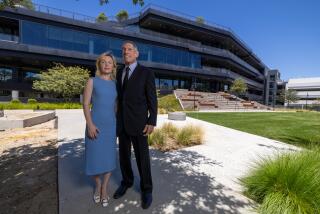Another Victory in the Quest to Transform Downtown
The reinvention of downtown Los Angeles as a lively and interesting place to live is no longer a matter of hopeful conjecture, but a likelihood, if not an inevitability. I’d been keeping a sympathetic, though unconvinced, eye on the phenomenon for a couple of years, watching the progress of prophetic redeveloper Tom Gilmore as he transformed three abandoned buildings in the Old Bank District into 230 clever loft apartments now fully occupied. What finally tipped the scales of belief for me, however, was spending time recently with a chap named Mark Weinstein.
Weinstein is a 43-year-old son of Canoga Park. He has a floppy mop of gray hair and enormous trouble sitting still. Trapped in a chair, he continuously jiggles his hips, bangs his knees together and toggles his feet from edge to edge. The man is a giant exposed nerve ending.
Weinstein’s company, MJW Investments, has begun work on a project that likely clinches ultimate victory for the forces of downtown transfiguration. Between now and the end of 2004, it will redo 10 mostly contiguous old manufacturing and office buildings it owns along Los Angeles Street in the Fashion District, producing 604 loft apartments and something like 1,500 new residents for the city center. Eight of the buildings compose an entire block between 7th and 8th streets. It’s by far the largest such effort ever undertaken downtown.
Called Santee Court, it will cost $120 million. The zoning, layouts and other so-called “entitlements” have been approved by the city. Final financing, Weinstein says, is in his pocket. He vows that the first phase, involving three buildings and 171 units, will be renting by the end of next year. “We are a very proactive company,” he says. “We never let anyone hold us up.”
Standing atop one of his buildings, at 746 Los Angeles, Weinstein looks down on the alley that connects the structures (he owns it, too). Where I see loading docks, small parking lots and windblown litter, he sees a cobblestone way lined with hip cafes, bars and shops that open all the way through to Los Angeles Street. He sees a courtyard area with landscaping and a fountain. “Like the Third Street Promenade in Santa Monica,” he says. “Like Old Town Pasadena.” Santee Court will succeed because it provides its own critical mass, while adding to the slowly accreting mass destined to explode in a blaze of resident-friendly redevelopment throughout downtown.
Weinstein, who has developed 3 million square feet worth of residential and commercial property (including in Old Town Pasadena), describes himself as an “accountant-type developer” who doesn’t take undue chances. He puts substantial amounts of his own money into his projects. Unlike Gilmore, he doesn’t buy shuttered structures, but rather “living buildings” with tenants who provide an income stream during renovation. After purchasing the Santee Court buildings in September 1998 for $18 million, he waited to see if Gilmore’s project would take wing before committing to turning nine of his 10 structures into housing. All 604 of his proposed units, moreover, are designed to condominium specifications, in case selling them makes sense in the future.
Santee Court, Weinstein says, is meant to be “work force affordable,” with rents starting at $700 (and a median rent of $1,200). He’s especially targeting city cops, firefighters, teachers and other public employees. He has also earmarked 20% of the units for low-income people, which allows him to sell special federal tax credits to investors.
But Weinstein, bouncing fervently in his chair, says his commitment in the latter regard is a matter of soul, not just sense. “I grew up in a lower-middle-class family in Canoga Park. I used to look at the fancy buildings in Beverly Hills and wonder why everybody couldn’t live together, so lower-income people could live with higher-income people and they’d all get to know each other. I mean, when it comes down to it, we’re all the same, aren’t we?”
We sure are, but the suburban-sprawl mentality that’s dominated Los Angeles has pretty uniformly segregated like with like. L.A., however, has about reached its physical limits, and a shortage of housing still exists. The central city, with its sturdy, enchanting old structures, can no longer be ignored.
What’s more, a young and vibrant segment of the populace has turned away from the oxymoronic concept of a suburban city. Hungry for a diverse and edgy urban life, they’re devouring unconventional downtown living space as fast as it hits the market. According to Central City Assn. estimates, renovation projects and new construction will have added, by the end of next year, something like 3,500 residents to the 18,000 already living downtown. Moreover, the new arrivals will be of the sort who are bound to generate more nearby places to shop and socialize.
What Weinstein and his eccentric ilk are riding isn’t just another wispy L.A. trend. It’s the maturation, at long last, of an enormous city that’s been a flighty adolescent for much too long.


